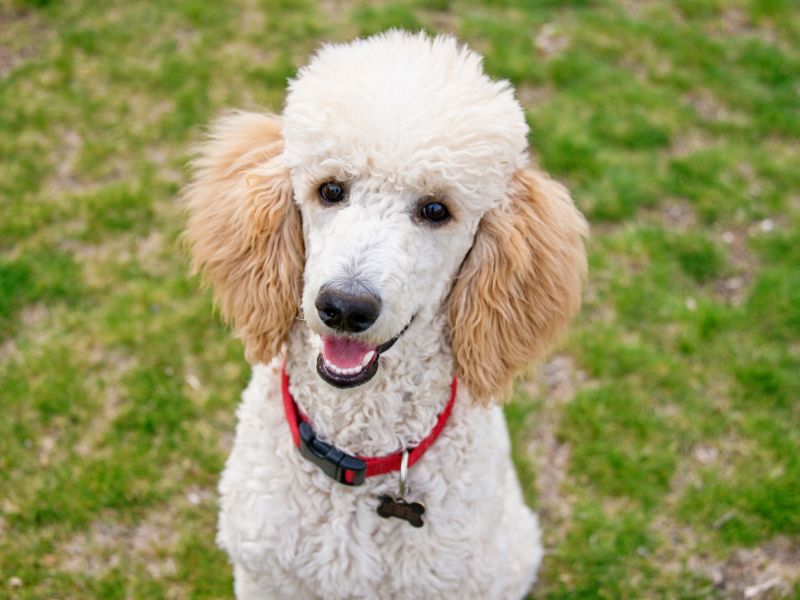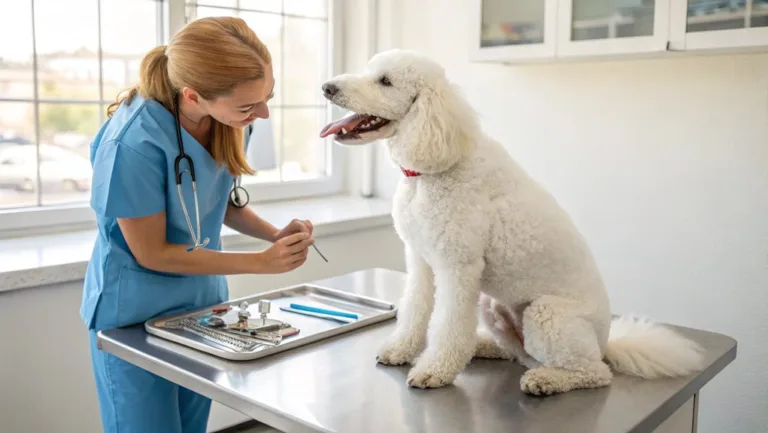Poodle Bite Force: PSI Dog Bite Force for This Popular Breed

You might be surprised to learn that poodles, often associated with elegance and prim grooming, possess a surprisingly strong bite force.
While not as powerful as some larger working breeds, poodles can pack a punch when it comes to their jaws.
But what exactly determines a poodle’s bite strength, and how does it compare across the breed’s different sizes?
Understanding the factors behind poodle bite force isn’t just a matter of curiosity—it’s essential knowledge for owners and potential adopters alike.
As you consider the implications of this canine characteristic, you’ll discover there’s more to these sophisticated dogs than meets the eye.
Understanding Poodle Bite Force
Diving into the world of poodle bite force reveals some surprising facts. While poodles aren’t typically associated with powerful bites, their history as water retrievers has endowed them with a strong jaw.
The bite force of a poodle varies depending on its size, with standard poodles possessing the mightiest bite among the three sizes.
The bite force of a poodle isn’t just about raw power. It’s influenced by factors like temperament, socialization, and training.
A well-socialized and trained poodle is less likely to use its bite force aggressively. In fact, poodles are generally not aggressive dogs, but they may bite if they feel threatened or fearful.
Understanding a poodle’s bite force is essential for responsible ownership. While standard poodles have a stronger bite than their smaller counterparts, it’s important to remember that bite strength doesn’t equate to aggression.
Proper training and socialization from an early age can help guarantee your poodle uses its jaw strength appropriately.
By focusing on positive reinforcement and creating a safe environment, you can minimize the risk of bite incidents and foster a well-behaved companion.
Factors Influencing Poodle Bite Strength
Several key elements contribute to a poodle’s bite strength. The size of the breed plays a significant role, with standard poodles typically having a stronger bite force than their miniature or toy counterparts.
Jaw strength, influenced by the poodle’s genetic makeup and physical structure, directly impacts their bite force measured in PSI (pounds per square inch).
Training and socialization are essential factors affecting a poodle’s bite inhibition. Well-socialized poodles are less likely to use their full bite force, even in stressful situations.
Proper training helps them understand when and how to control their jaw strength, reducing the risk of accidental or intentional bites.
A poodle’s temperament also plays a pivotal role in their bite strength application. Calm, well-adjusted poodles are less prone to aggressive biting behavior, while anxious or fearful dogs may exhibit stronger bites when feeling threatened.
It’s important to remember that poodles weren’t originally bred for aggression, but rather as water retrievers. Their bite force is a hallmark of their historical role, not an indicator of aggressive tendencies.
Comparing Poodle Sizes and PSI

Poodles come in three distinct sizes, each with its own bite force capabilities. When comparing the bite strength of toy, miniature, and standard poodles, you’ll notice significant differences in their PSI (pounds per square inch) measurements.
Toy poodles, being the smallest of the breed, have the lowest bite force. Their PSI is comparable to other toy breeds, typically ranging from 150 to 200 PSI.
Miniature poodles, with their slightly larger size, possess a moderately stronger bite force, usually between 200 to 250 PSI.
Standard poodles, as the largest variant, boast the most impressive bite strength among the three sizes. Their bite force can reach up to 300 PSI or more, reflecting their historical role as water retrievers.
This higher PSI allows them to firmly hold prey without causing damage, a trait inherited from their retriever background.
It’s important to note that while standard poodles have the strongest bite force, they’re not known for aggression.
Their bite strength is a verification of their working heritage rather than an indication of temperament.
Proper training and socialization are key factors in ensuring all poodle sizes use their bite force appropriately.
Poodle Bite Force Vs Other Breeds
When comparing poodle bite force to other breeds, it’s essential to contemplate the context of their size and purpose.
Poodles, particularly standard poodles, have a respectable bite force that aligns with their history as water retrievers.
However, their bite force doesn’t match that of larger working breeds like German Shepherds or Rottweilers.
You’ll find that a poodle’s bite force is more comparable to breeds of similar size and purpose. Their moderate prey drive and generally calm temperament mean they’re less likely to use their full bite force in everyday situations.
This contrasts with breeds specifically bred for guarding or protection, which may have both a stronger bite and a higher tendency to use it.
It’s important to remember that bite force alone doesn’t determine a dog’s potential for aggression.
Proper socialization and training play pivotal roles in shaping a dog’s behavior, regardless of breed. While poodles aren’t known for aggression, any dog can bite if provoked or scared.
The key is understanding your poodle’s needs and providing appropriate training to guarantee they become well-adjusted companions, utilizing their intelligence rather than relying on physical force.
Myths About Poodle Aggression

Despite their reputation as intelligent and loyal companions, poodles often fall victim to misconceptions about their temperament.
One common myth is that their fancy groom indicates a delicate or aggressive nature. In reality, poodles are far from aggressive, possessing a low prey drive and excellent trainability.
Another misconception is that poodles are high-strung or nervous. This couldn’t be further from the truth.
Poodles are known for their even temperament and adaptability. Their intelligence allows them to assess situations calmly, making them less likely to react aggressively.
Some people believe that poodles are aloof or unfriendly. However, with proper socialization, poodles are incredibly affectionate and bond closely with their families.
Their intelligence makes them highly responsive to training, further reducing any potential for aggressive behavior.
You might hear that poodles are prone to biting. This myth likely stems from their history as water retrievers.
While they’ve a strong jaw, poodles aren’t inherently aggressive. Like any dog, they require proper training and socialization to become well-adjusted companions.
With the right care, you’ll find poodles to be gentle, loving, and far from aggressive.
Preventing Poodle Bites
A well-trained poodle is a joy to be around, but even the gentlest dog can bite if provoked or scared.
To prevent poodle bites, start with early socialization and proper training from an early age.
Expose your poodle to various people, animals, and environments to build confidence and reduce fear-based reactions.
Teach bite inhibition by redirecting play nipping to appropriate toys and using positive reinforcement to reward gentle behavior.
Consistently praise and reward your poodle for calm, non-aggressive responses to stimuli.
Recognize signs that your poodle is fearful or threatened, such as growling, tucked tail, or raised hackles. Remove your dog from stressful situations and work on desensitization techniques to build tolerance.
Never punish your poodle for growling, as this may lead to biting without warning. Instead, address the underlying cause of the growl.
Supervise interactions between children and your poodle, teaching kids to respect the dog’s space and boundaries.
Regular exercise and mental stimulation can help prevent frustration-based aggression. By implementing these strategies, you’ll minimize the risk of poodle bites and foster a happy, well-adjusted companion.
Training for Bite Inhibition

Building on proper socialization and early training, teaching bite inhibition is a key aspect of raising a well-mannered poodle.
Bite inhibition refers to a dog’s ability to control the force of its bite, which is essential for preventing accidental injuries during play or moments of stress.
To train your poodle for bite inhibition, start early in puppyhood when they’re naturally playful and mouthy.
When your poodle nips too hard during play, yelp loudly and stop the interaction immediately.
This mimics how puppies learn from their littermates and teaches them that biting too hard ends the fun.
Use positive reinforcement training to reward gentle play and discourage rough behavior.
Offer appropriate chew toys to redirect your poodle’s natural urge to bite and nip. Consistently praise and treat your poodle when they play gently with their toys or with you.
Continue socialization throughout your poodle’s life, exposing them to various people, animals, and environments.
This helps prevent fear-based biting and builds confidence. Remember, patience and consistency are key in developing your poodle’s bite inhibition skills.
Conclusion
You’ve learned that poodle bite force varies by size, ranging from 150 to over 300 PSI.
Remember, this strength doesn’t equate to aggression. Your poodle’s heritage as a water retriever explains its bite force.
Don’t fall for myths about poodle aggression. Instead, focus on proper training and socialization to prevent bites and promote a well-adjusted temperament.
With the right approach, you’ll have a calm, friendly companion, regardless of your poodle’s size or bite strength.






